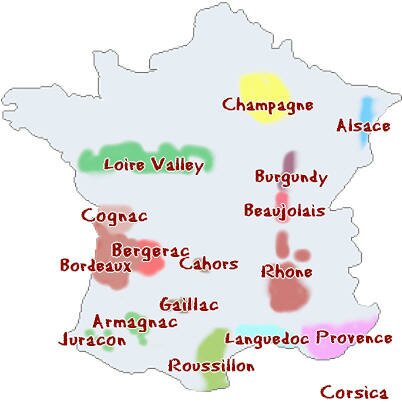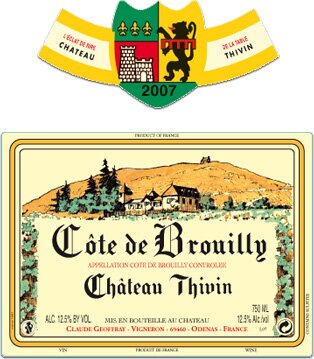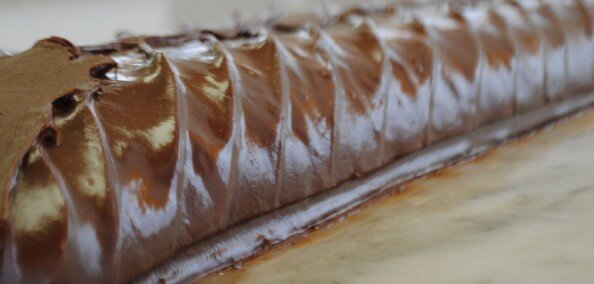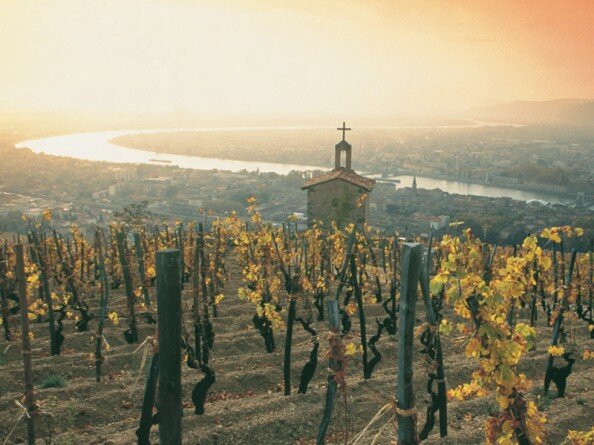
Category Archives: GUD Blog
Some Beautiful 2010 Burgundy
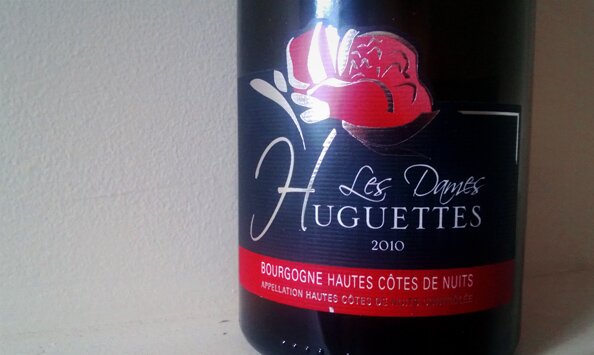
Good burgundy is magical. It occupies more room in my cellar than any other wine, I think about it more than any other wine, and I do genuinely enjoy it more than any other wine. But of course, good burgundy is also really fucking expensive.
Well, most of the time.
Fortunately, Evan Barrett at Plum Market in Bloomfield was recently selling a nice bottle for me to fawn over. From a somewhat unheralded parcel of land called Les Dames Huguettes, this isn’t fancy stuff. The vineyard is from the Hautes Cotes du Nuits, which is a stretch west of northern burgundy known mostly, I believe, for making cheap plonk that ends up on supermarket shelves under the faded, laminated sign that says “FRANCE.”
By contrast, Les Dames Huguettes is, as I understand it, the only chunk of land in the Hautes Cotes for which the name may appear on the label. In other words, the French wine police think it’s not exactly a shitty place to grow grapes for wine. I agree.
This particular bottle is young and juicy, full of fruit. But there’s a lot of acid to it. It’s a very delicious, natural fruit flavor. Incredibly fresh stuff with a nice mineral edge and a finish that lingers. This is seriously delicious. And for around 30 bucks (or so), it’s a very reasonably price for entry level burgundy.
The label struck me as kind of odd and whimsical, so I was surprised by the seriousness of what’s in the bottle. As it so happens, this is produced by Domaine Mongeard-Mugneret, a classic burgundy producer with wines from some of the most sought after grand crus in all of burgundy. So I guess they’re actually slumming it a bit, but hey, good for us.
Those who attended our “Wine Soak” tasting back in April would recognize similarities between the burgundy we tasted there and this bottle. Both from 2010, each wine has the same incredible transparency through the wine to the fruit itself, despite the fact they’re both inexpensive wines. And despite the allegedly less-than-stellar vintage, which was wrought with frost problems leading to dead vines and low yields. But the wines I’ve tasted from that year are spectacular in exactly the same way. I’ve seen plenty of wine critics online indicate that the best winemakers quietly had standout years in 2010 with beautiful, elegant wines, and it’s hard to disagree based on my limited experience.
Anyhow, if there’s any of this left around Michigan, burgundy lovers who aren’t so much blessed with the fat ass pocketbooks should grab some while they can.
Wine Soak @ Signal-Return: Introduction to French Red Wine
It’s been a while in the making but a new Wine Soak event is finally here! We’re going to be drinking some kick-ass wines in a very cool space. Details are posted below.
http://www.eventbrite.com/
Wine Soak @ Signal-Return: Introduction to French Red Wine
When: 6:30 p.m. – 8:30 p.m., Thursday, April 25th
Where: Signal-Return – 1345 Division Street in Detroit’s Eastern Market
What’s the difference between the Loire Valley and the Rhone Valley? How is it that Languedoc-Rousillon produces a third of all wine in France yet you don’t see many bottles from this region on the wine store shelf? Why do some Burgundy and Bordeaux sell for hundreds of dollars a bottle? Does all Beaujolais smell like bubble gum? (No!) Can you find a good wine from any of these regions without taking out a loan? (Yes!)
We’ll explore these and other questions while hanging out and drinking at Signal-Return, a working letterpress studio that offers workshops and open studio time in the historic Eastern Market district. Our team of talented drinkers will select a specific red wine to represent each of six different regions of France: Beaujolais, Bordeaux, Burgundy, Languedoc, Loire, and Rhone. Each region will have its own short presentation, followed by open discussion.
If you’re hip to discovering new wine in a casual environment with a fine group of people, Wine Soak is where it’s at.
Wine Soak: Introduction to French Red Wine will be held on Thursday, April 25th at 1345 Division Street in Detroit’s Eastern Market. Doors open at 6:30 p.m. Presentations will begin at 7:00 and end at 8:30. Limited seating is available for the ridiculously low price of only $30 per person. Cost includes a pre-game glass of sparkling wine, 2 oz. pours of six different wines, and pizza from Supino Pizzeria.
Wine Soak is a wine tasting and discussion series designed for all levels, from novice to professional. Each event covers a different varietal, region, or theme, with a brief review of wine basics, sampling of six to eight different wines, and a rotating venue. No posing. No bullshit.
Special thanks to Southeast Michigan’s Premier Merchant of French and Spanish Wine since 1992, Elie Wine Company.
Tasting Notes from the Cellar
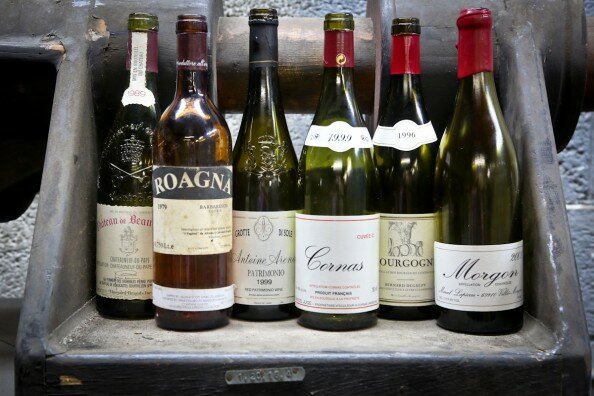
There are lots of ways to put together a collection of older wines. Collect and store them in a cellar, buy them from a reputable merchant who has stored them, steal them from a friend, find a store that has found a so-called library release of wines aged at the winery, et cetera. Each of these methods (Except stealing. I think.) were put to use a couple weeks back when a group of us got together to drank some older wines.
A few notes, recorded for posterity’s sake…
1979 Roagna Barbaresco
Delicious from the start, this might have been my favorite wine of the evening, opening up to a beautifully tart and fruity wine with very noticeable spicy and herbal undertones. Tarragon? Mint? Tobacco? Umami? A really nuanced wine that moved from being a bit tannic to downright light and lively. As Todd said, the “most complete wine” of the evening.
1989 Beaucastel, Chateauneuf de Pape
Earthy and big to start, it finished with an edge that smoothed out and opened up over time. A little funk early on that blew off quickly. Lots of fruit, though, even from the onset. Steve observed it might be on the downside of its life. But after a couple of hours, the leather and tannin subsided a bit. Pretty classic; a fine drink.
1999 Antoine Arena, Patrimonio
Dark, deeply colored, full of sediment, brooding aromas to start. Dirty, tannic, earthy wine. Some minerality and acid. Looks brooding, full of flavor, but surprisingly youthful. I wish I’d taken more detailed notes, but the general sentiment was that this was in a good place. Steve observed in retrospect that it was hard to wrap his head around this, and I agree: It was the biggest of the all and came late in a long night of drinking.
1990 Bongran Macon Clesse
 Remarkably unique. Truly. Drew a chorus of quizzical looks and comments. Todd described the aromatics as being a lot like coffee beans, and Putnam began to latch onto that as a descriptor for the flavor as well. I think I see what they were getting at in terms of a the long, slow, earthy quality of the fruit. Floral and honey notes. Not sweet but clearly botrytized grapes. Lots of tropical fruit but not of the predictable sort found in so many overly engineered wines. Some in the group felt it would be hard to drink this in any serious quantities, me among them, but it’s hard to deny its brilliance.
Remarkably unique. Truly. Drew a chorus of quizzical looks and comments. Todd described the aromatics as being a lot like coffee beans, and Putnam began to latch onto that as a descriptor for the flavor as well. I think I see what they were getting at in terms of a the long, slow, earthy quality of the fruit. Floral and honey notes. Not sweet but clearly botrytized grapes. Lots of tropical fruit but not of the predictable sort found in so many overly engineered wines. Some in the group felt it would be hard to drink this in any serious quantities, me among them, but it’s hard to deny its brilliance.
1996 Dugat-Py Bourgogne Rouge
I wonder what this cost on release. No famed crus on the label. Just good wine in the bottle that has lasted until now. Light, refreshing, but still structured. As Putt said, it’s “chuggable.” Of course, Putt thinks whiskey is “chuggable.” But still, I tend to agree. We also had a 1995 Marechal Pommard, and the Dugat-Py was in a far better place. The other was gnarled and dare I say backward whereas this was simply pretty.
1999 Juge Cuvee C Cornas
Coming after a puckeringly tart Morgon and even the Chateauneuf, this was downright jammy. Young and fruity. A nice dose of acid, but compared to other wines, this really seemed sweet. Delicious but didn’t really suck me in the way some others did.
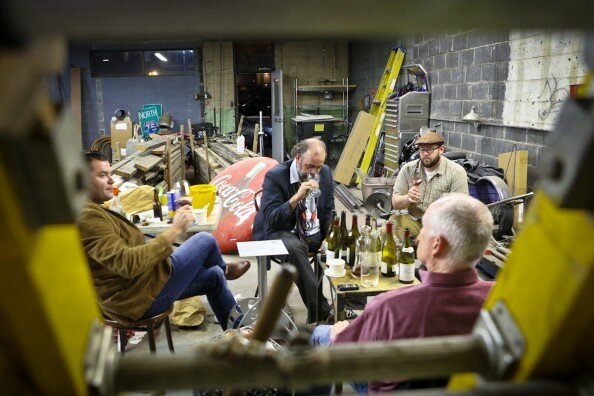
Chateau Thivin Cote de Brouilly: Why This $20 Wine is Better
I’m always trying to sniff out bottles of wine that supply the most gratifying drinking experience for the price. Some people call these “value wines”.
But it ain’t easy.
The vast majority of wine under $10/bottle is made to be consumed immediately and with little fanfare. In this price range you’re going to find a lot of idyllic back label stories that read like tourist guides to the Elysium Fields. The truth is — and here you can make an honest comparison to the realm of domestic beer — as many beer-only drinkers find their ice-cold American lager brand of choice to be a flawless beverage no matter what the situation, some wine drinkers will swear by $6 bottles of perfectly unremarkable chardonnay. That’s fine if you just want to catch a buzz.
At a local Indian restaurant that “allows” BYOB, I watched as a threesome were seated and one of their party subsequently pulled out a bottle of white zinfandel and two cans of Busch Light from his jean jacket. It seems to me that if you’re going to surrender your taste buds to the relatively exotic flavors of the Indian Subcontinent, you ought to at least have a simple Riesling or a malty Pilsener to wash it all down. This merely illustrates that most of the time familiarity rules — especially when the price is right.
You can find a wine with character for $10-$15. A value wine. One that pops into mind is Domaine de la Fruitière Chardonnay. Here is a dry, white wine that probably won’t change your philosophy but it does combine the richness of chardonnay with the crisp mineral structure of traditional Muscadet, and when slightly chilled, drinks agreeably in the shade of an oak tree near your favorite swimming hole on a warm July day. If you’re one of those aforementioned, strict chardonnay drinkers, here is a risk-free way to expand your palate.
If you are a wine enthusiast with a limited budget and a desire to learn, the $15-$25 range is ripe with good wine of character. This is your sweet spot. Unfortunately, there is also a lot of ordinary wine with large brand marketing budgets in this group. A trustworthy wine merchant is vital to lead the way here.
The trustworthy wine merchant is going to carry things like Château Thivin Côte de Brouilly for a little less than $25. But what makes this particular wine better? Why is it three times the price of Yellow Tail merlot?
The reasons are many. For one, it’s drinkable. I have consumed at least a half dozen bottles of this wine in the past few months with different people. With the exception of one person that was exceedingly sensitive to tannins, we all loved it. But drinkable does not mean simple. A glassful is all berries and flowers and wet stones. It’s tart and refreshing, with a minerality that grips at the finish. There is an integration of aromas, textures and flavors that elevate this wine well above the grocery store bottles. In short, it tastes like more than just fermented fruit juice.
Secondly, it’s from somewhere. Part of the pleasure derived from fine wine is creating a connection to a place. In this case we can identify it from the Beaujolais winemaking region of France. Further, it is from Brouilly, one of ten Cru Beaujolais, (the highest category of classification in the region). Even further, this wine is from vineyards in the sub-district of Côte de Brouilly, from the steep slopes of Mont Brouilly, where the soil is composed of volcanic blue stone. It’s kind of like one of those international espionage movies that zoom into a spot on earth from a satellite camera in orbit, except we witness a grape farmer tending his vines, not the assassination of a high level diplomat.
And finally, for the enthusiast, it’s educational. Compare this wine to other Cru Beaujolais in the same price range. Because all are made from gamay grapes, you begin to get a sense of how climate and soil can affect the finished wine (terrior!). And because Cru Beaujolais can sometimes develop over three to ten years, you can afford to let a few of these sit in the cellar and see how they change with time.
A typical question from wine novices when confronted with wine prices ranging from $3 to $300 is: Do you get what you pay for? I’ve struggled with this question myself after I decided I that I really, really like wine. A lot. And I still struggle. The general answer is complex and can include things like hand-harvesting, barrel-aging. Both of which are applied to Château Thivin Côte de Brouilly. So, in this case, I believe it’s a resounding yes. Buy some and invite me over for drinks.
Curious Foods of the North – Stories behind some of northern Michigan’s most popular fare.
Driving East on U.S. Highway 2 through Michigan’s Upper Peninsula between Naubinway and St. Ignace you are sure to see three things: a crystal blue Lake Michigan to your right, thick evergreen and hardwood forest to your left, and ahead, signs for pasties, smoked fished and fudge. How did these three distinct foods come to symbolize the north?
A Moveable Feast
Although regrettably sharing the same name as decorative nipple coverings, Michigan pasties are much tastier. Similar to pot pies but without the pot, these portable meals were a favorite of immigrants working Upper Peninsula mines before they were standard tourist fare.
Introduced in the 19th Century by Cornish miners, the hearty pasty could easily be eaten end to end, without knife or fork, and even reheated on a shovel held above a headlamp candle. Finns and Swedes, who were also working the mines, contributed their own culinary influences to the UP pasty.
The mining industry eventually collapsed but the UP pasty remained. Today, you can find pasties filled with chicken, fish, or simply vegetables. Some places will smother them in tomato sauce and melted cheese. You can even find them “Mexican style”.
The most satisfying UP pasty is filled with beef and diced vegetables (we like it with earthy, sweet rutabaga), has a solid crust, and comes with a cup of brown gravy on the side. It is best eaten on a chilly autumn day while the wind whips the Mackinac Straights into a white froth. A couple glasses of whiskey as digestif are optional though highly recommended.
Are You Calling Me a Fudgie?
The world is flooded with candy that has been processed and packaged in factories then shipped to corner convenience stores. But in Mackinac it’s old school copper kettles, marble tables, and sweet cream.
Every batch of fudge is handmade. When the syrup reaches what candymakers call the “soft ball stage” it’s poured onto marble and slowly manipulated with spatulas into logs. It’s said that this long cooling process, particularly during humid summer days, is what makes Mackinac fudge unique – its terroir, if you will.
True or not, this type of candymaking hearkens back to the days of people working with their hands and fits right into the wistful Mackinac Island experience where many a summer vacation memory has been made.
We prefer enjoying locally made fudge away from the throng of tourists in and around Mackinac. A short drive west is Wilderness State Park. Or head east to Cheboygan State Park. Both parks boast amazing forest and shoreline hiking opportunities. No better way to work off a giant hunk of fudge than a brisk few miles on foot, Bald Eagles soaring overhead.
Just Water, Salt and Smoke
It’s not so curious that a land and people surrounded by freshwater seas enjoy their fish. From Leland near the popular Sleeping Bear Dunes to remote Whitefish Bay to Houghton-Hancock and all points around and between, smoked fish finds its way into most every cabin in the northwoods.
Unlike thinly sliced lox that’s cold-smoked for preservation, northern Michigan fish are hot-smoked and thus the flesh is textured more like cooked fish. The process is simple. The fish, normally whitefish, salmon or trout, is brined in saltwater and placed in racks over smoldering logs. The wood used for smoking is often maple, another abundant local resource.
Though smoked fish can be made into a dip or even a sausage this classic northern Michigan dish is best enjoyed simply on a cracker. Pair it with a glass of crisp white wine, a lover, and the remains of a day gone orange behind the pines.
Slideshow: The Next Urban Chef
Chef Andy Hollyday wandered out from behind his burners to check on our table, “How was everything?” We all nodded, our mouths full of food, and mumbled our appreciation. It’s a scene I’d witnessed several times, the chef taking a few moments to check in with his customers. Except generally, I’m seated at Roast, and Andy’s cooks are typically old enough to grab a beer after work.
Last Saturday, though, it was an entirely different setting: Andy’s kitchen was a range and a few tables in the corner of Eastern Market’s Shed 5, and his team consisted of a handful of local students participating in The Next Urban Chef, a food system education project put together by Detroiter Alison Heeres.
Hollyday joined Corrdor Sausage’s Will Branch, The Sunday Dinner Company’s Eric Giles, and Supino’s Dave Mancini as team leaders, about a dozen students learning and working under their guidance to learn about food, local agriculture, and teamwork.

The competition was judged, with each team preparing three dishes and their subsequent scores being allocated based not just on the food but on their ability to work together and their use of Michigan ingredients.
Hollyday’s team, which won the competition, besting reigning champ Dave Mancini, prepared sweet corn ravioli with shrimp, roasted chicken with an apple cider vinegar sauce and Swiss chard, and an apple rosemary tart with homemade vanilla ice cream. I’m fortunate enough to say that I tried all three courses, and Chef Andy and his students did a great job.
To learn more and be privy to info about next year’s event, check out their Facebook page.
Drinking 2009 Jaboulet
Since the early 19th Century, Paul Jaboulet Aîné has been rocking folk’s taste buds with wine produced in France’s Rhône Valley. If you’ve ever browsed the French section of a wine store you’ve likely seen their Côtes du Rhône Parallèle 45, an entry-level southern Rhône blend of Grenache and Syrah.
But they built their reputation through parcels in the northern Rhône, Hermitage La Chapelle being the most famous. The 1961 vintage of Hermitage La Chapelle has achieved an almost mythical status among the wine cognoscenti (only $12k/bottle for those of you with a little extra disposable income).
Things weren’t as bright for Jaboulet through the 90s and into the new century. Production was up but quality was patchy. In 2006, the Frey family (proprietors of Chateau La Lagune in Bordeaux) purchased Jaboulet and applied sweeping changes that included a stricter selection process and significantly lower yields.
This is all just the long way of saying we hung out at Café Muse the other day and drank some 2009 Jaboulet with Elie. It was tasty.
My notes:
Châteauneuf du Pape “Domaine de Terre Ferme”
We started with the one southern Rhone in the bunch. Aromas of purple jelly led into wood smoke. Full body across the palate finishes long and herbal. This wine wanted to arm wrestle with me but I declined.
Côte Rôtie “Domaine des Pierrelles”
An elegant wine. On the nose there’s an initial hit of buttered toast and fruit compote that morphs into cedar and then flowers and then other lovely things our ancestors would know better than us. It somehow balances heft and grace like a ballerina that throws shot put as a hobby. All of the wines had plenty of acidity but it shone brilliant in this one, long and juicy. I’m writing this note a week later and I still get all tingly just thinking about it.
St. Joseph “Domaine de la Croix des vignes”
Fat with aromas of ripe fruit. Balanced across the center. There is weight here and also a long and dry finish sprinkled with powdery tannin.
Cornas “Domaine St. Pierre”
Immense nose of crushed berries and meat. Once you make it past the massive tannins a long and happy acidity shows. The provided tasting notes mention that you might want to cellar this monster for at least a decade before drinking. I believe those notes.
Crozes Hermitage “Domaine de Roure Rouge”
Heady aromas of stones, river banks, flowers, cedar closets, etc…all swirly and turning into steamed fruit and everything else. Fat, almost sweet through the middle yet finishes with a lively acidity. I can’t get my nose out the glass and I even save a bit for later sniffing.
Hermitage “La Petite Chapelle”
Nothing small about it. A dense and succulent drink of wine beneath scents of black currant liqueur and herbs.
Hermitage “La Chapelle”
If I counted off the aromas and flavors it would read like a French country village market shopping list including a side of beef. It is said that this wine will age 50 years. Grab a case and you might make your grandkids rich.
Pizza Catharsis

It’s been a long week. First, I was up working until 1am three days in a row, which sucked pretty hard. Second, I partied pretty late on Friday. And third, I woke up Saturday morning only to pay witness to a television commercial advertising a wireless cable box that lets people watch their TVs on the patio and in the kitchen and presumably on the crapper. Wireless cable boxes. A notion so grotesque that it made me vomit all over the place.
Well, not really. But I nevertheless needed to get some relaxation. Since my personal masseuse has Saturdays off, I opted to occupy my day of repose with cooking. I had a bunch of tomatoes, a ball of fresh mozzarella, and some lamb merguez sausage from Corridor Sausage sitting around, so en route to Eastern Market that morning I decided to make pizza.
For the past two weeks, I’ve been visiting the Grown in Detroit stand, acquainting myself with papalo, an herb that apparently grows wild across Mexico and some of the southwest United States. It’s not quite as concentrated as cilantro or basil, but it nonetheless packs an awful lot of flavor in a single leaf, simultaneously bright, earthy, and green. The plants can get as tall as 6 feet in prime conditions, and the leaves themselves are about 1 or 2 inches across. The Wikipedia page says it’s also popularly known as Bolivian Coriander. And in its native Mexico, it’s ostensibly served similarly to cilantro, as a fresh herb to accent pork tacos or spicy sandwiches.
I had put it on sandwiches and in eggs last week, so last night, I opted to throw it on a pizza. But not, like, literally throwing or anything. Because that mess would have made a shit hole out of my kitchen.

With onion, papalo, cheese, and sausage in hand (If you’re so moved by the phrase “sausage in hand,” please stop reading, snicker, and take a breath before moving on. No one’s judging.), I moved on to consider an appreciate sauce for my burgeoning pie. Given the Latin-inspired flavors in the meat, I briefly flirted with the idea of a BBQ sauce-based pizza. I definitely like a well-made BBQ chicken pizza as much as the next dude, but I knew wanted to write a blog post so I could mention the papalo. And if I used something as cliche as BBQ sauce for a southwest-style pizza and then wrote about it, I’d have to hurl myself into traffic.
So instead, I threw some tomatoes and a red bell pepper on the grill and charred the living shit out of them, setting them aside as the base of my sauce (more on that later). As I’d hoped, the char gave it more depth than it might have had otherwise.
I mixed together some pizza dough from Peter Reinhart’s Artisan Breads Every Day, a blend of 50% bread flour and 50% whole wheat flour, assembled most of my pie, and slid that shit onto my blazing hot pizza stone in an oven that’d been sitting at 475 degrees. After 4 minutes, I rotated it, added the papalo (I often add leafy toppings a bit late in the process so they don’t get burnt ), and then finished it up.
The results?
Pretty damn good, I’d say. I didn’t get the crust totally perfect, but it was my first time with that particular recipe. And the toppings were totally killer: As always, the products from Corridor Sausage are delicious, the papalo worked out really well, and so on. Nothing revolutionary by any stretch but tasty to be sure.
Should you want to make something similar in the future, I’d recommend starting with the sauce because (a) it’ll be a big ego boost for me personally and (b) it tasted pretty damn good.
To begin, get a single red bell pepper and enough tomatoes to make a couple overflowing handfuls once chopped. Before you go cutting on things, fire up your grill, put the tomatoes and the pepper on it, and cook until the pepper is nice and charred and the tomatoes are soft but not falling apart, kind of like a teenage girl watching Sleepless in Seattle for the first time ever. Skin the pepper entirely and skin most of the tomatoes, leaving some blackened yumminess in the mix.
Then chop them until you’ve basically made a pile of goo. Cook about a quarter of a small onion, minced, and some garlic, also minced, in your sauce pan using some olive oil. Add the tomato goo at the appropriate time, throw in a bay leaf, add maybe a teaspoon or so of vinegar to your liking, add a bit of salt and pepper, and then heat until it has the consistency of a tomato sauce. If you don’t know what any tomato sauce looks like, how the hell have you read this far? Just stop now.
Taste the sauce at this point, removing the bay leaf and being absolutely certain to not to scald your tongue like a buffoon. I rather enjoyed it on the tart side, but I still added a bit of sugar, stirring it in until it dissolved. I cooled it then used it on the pizza few hours later. I had barely any left, so consider this a single serving recipe.
Also, check out the papalo at Grown in Detroit if it’s still around for the next couple of weeks. I’ve enjoyed playing with it quite a bit and the flavor, while not notably powerful, lingers on your palate for a long time.
* * * * *
And in conclusion, I leave you with this pizza making tutorial and a friendly reminder that when you put stuff on the internet, people will find it and may laugh at you.
Domaine Abbatucci
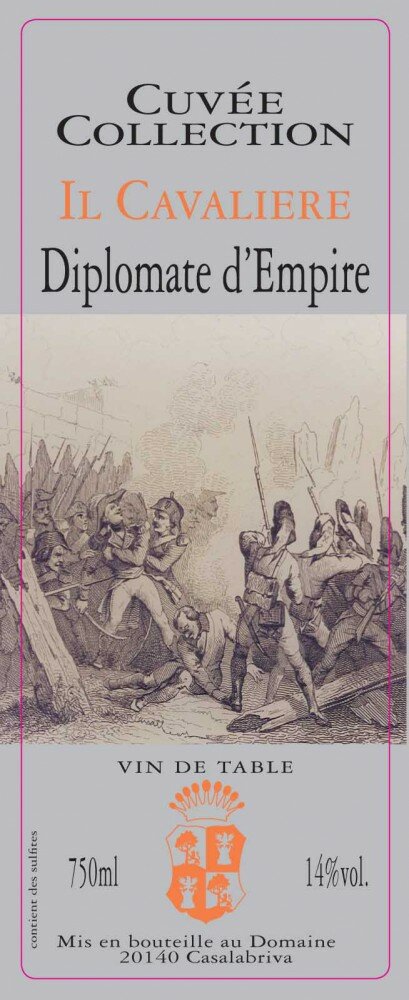 During dinner with some friends on my patio last night, I opened a bottle of Corsican wine about which I knew next to nothing. It really illustrates one of the things I love about wine, which is that there’s always something new to learn. Whether it be a comparative tasting of different vintages or chemistry or culture or tracing the lineages of grapes, the dive into a wine’s origins can be an absolutely endless journey.
During dinner with some friends on my patio last night, I opened a bottle of Corsican wine about which I knew next to nothing. It really illustrates one of the things I love about wine, which is that there’s always something new to learn. Whether it be a comparative tasting of different vintages or chemistry or culture or tracing the lineages of grapes, the dive into a wine’s origins can be an absolutely endless journey.
Cuvée Collection “Diplomate d’Empire, Il Cavalière” from Domaine Abbatucci not only occupied a portion of the conversation last night, it has occupied my entire morning. Composed of 37% Vermentinu, 20% Rossala Bianca, 19% Biancu Gentile, 14% Genovese, and 10% Brustiano (from the Kermit Lynch website), the cepage was so foreign to me that I’ve been obsessing about figuring out what the hell all of these grapes actually are.
The wine itself was remarkably dense and rich: Very floral, fleshy nose with melon/white fruit aromas. Sweet on the palate, but not flabby at all. I tasted the fruit first and foremost, but there’s an inherent mineral-driven acidity/structure to it. Viscous and oily texture, it’s got a very serious weight to it and a finish that lingers. It’s really very interesting, luscious stuff. Very distinct and dare I even say unique. I wish I’d gotten a second bottle, because for all of its loveliness, I felt like it had more to offer had I given it a bit more time to breathe.
After having my mind blown, I decided to investigate the winery and those odd grapes a bit.
First, the winemaker has a fascinating history. His father is responsible for saving tons of native Corsican grapes, and they’re directly descended from Napoleon Bonaparte. This Cuvée Collection set of wines are all named after people who were involved in Napoleon’s life: So the Diplomate in question is actually a childhood friend of Napoleon who fought with him at the Battle of Waterloo. The details are outlined on Lynch’s website.
The grapes are equally interesting. Having compared the importer’s notes and the Domaine’s own website, I realized that while Lynch was listing the Corsican names for the grapes, they’re far more commonly known by their Italian names (or the synonymous French names). Vermantinu was obviously Vermantino, prized for its aromatic qualities. Rossala Bianca is, in Italy, Rossola Bianca, and according to a book by Oz Clarke, it’s synonymous with Ugni Blanc from France, most notable for its use in making cognac (where grapes that yield high acid are prized for the flavors it yields through distillation). Of course, Ugni Blanc is also, I believe, know as Trebbiano in Italy. Say what?
So the morning got off to a start that was, to put it bluntly, confusing as fuck.
I kept digging, though, and I could find nothing on Bianco Gentile except some references to other Corsican wines where it was consistently referred to as one of the “lost” varieties that’s recently been reclaimed. As I mentioned earlier, it’s the Abbatucci winemaker’s father who took it upon himself to wander the Corsican countryside and preserve grapes like Bianco Gentile from what would have otherwise been extinction in the 1960s.
I couldn’t find much on Genovese other than some references to a “Bianchetta Genovese,” which is ostensibly a non-descript Italian grape called Albarola according to Wikipedia and a few blogs. The subtle distinctions aren’t really all that important, I suppose, but while it’s known for its plantings in northern Italy, this Albarola simply must be at least a little different in Corsica (assuming its even related). The evolution of distinct ecosystems and how that impacts the resulting grapes is every bit as interesting to me as the food and cultural components to how a particular wine has evolved over time.
Similarly, do a Google search on the last grape, Brustiano, and about a million websites will tell you that it’s synonymous with Vermantino, but clearly the winemaker finds something different since he lists both Vermantino and Brustiano as components to his wine.
Regardless, this combination of mostly soft, semi-sweet grapes and Ugni Blanc created a drink that’s quite profound. Naturally, it’s available in limited quantities. The winemaker makes a number of wines, but the “Cuvée Collection” series are all from a single plot of these heirloom, indigenous grape varieties, farmed biodynamically (down to the weird ass moon cycle rituals) with low yields, and so on.
So its rarity and relatively lofty price tag are easy to understand.
This bottle was recommended to me by Elie Boudt at Elie Wine Company in Royal Oak. There are only two cases, so if you’re interested, get there soon. I drank it along side grilled halibut and veggies as well as a wheat berry salad with a distinctly provençal twist. Pretty much perfect.
Breaking News: Elitism Runs Rampant in Cocktail Bars!
We’re under siege, folks. Less than a year after the first dedicated cocktail bar opened in the metro Detroit area, elitism and ego-maniacal bartenders are ruining the spirit of the bar. Gone are the good old days of showing up to a bar, having a nice chat, and paying for whiskey with that lone dollar bill you had crammed into your pack of smokes.
Or at least, that’s what Christine Sismondo of Huffington Post is claiming.
I recognize that linking back to their post is exactly what they’re after with these types of trolls, but (a) our tiny ass website isn’t going to make much a difference one way or the other and (b) I hate the obnoxious practice of requiring a login from Facebook or Twitter in order to respond, so I’m going to write up my response (some uneducated folks might call it a “rant” or something) right here instead.
In comparison with cork-sniffing and vintage-cataloguing, quaffing cocktails seemed a lot more fun — and a whole lot less like work. That was 10 years ago, an era when cranberry juice reigned behind the bar, insisting on fresh citrus was considered crazy and the shaken martini was still de rigeur.
I find claims of sweeping elitism from those who, unlike those of us in and around Detroit, have had seemingly regular access to craft cocktails for a decade to be more than a little disingenuous. I wonder if the author went back to drinking nothing but Jack with sour mix and G&Ts for 5 years if she’d feel the same way.
After she gives us quick history of the resurgence of craft cocktails, we get this gem:
As bartenders are downright fetishized for their ability to combine specific spirits, I feel we’re losing some of the spirit of the bar. People are there to have a good time and meet people, not to pray at the altar of the cocktail.
OK, actually, I agree. After all, every moment of every day is all about ME, and the last thing I should do is go out to enjoy something interesting that someone else worked hard to make. Deriving pleasure from eating and drinking the result of someone else’s time and effort is so yesterday. Who cares if it’s a unique drink that I can’t make it at home? Pass the Blueberry Stoli.
Also, I find that I dine out just to fill up and chat with my friends, not to derive any real satisfaction from what I’m eating. I’m not there “to pray at the altar” of the chef, so I’m just going to patronize McDonald’s from now on. Why deal with pretentious servers talking about farmers and shit when I can just have a seat in an uncomfortable plastic booth and shovel food in my face while eking out a little conversation betwixt huge bites?
There are other aspects of fine drinking (as opposed to fine dining) that are less than democratic. Craft cocktail bars aren’t your drop-by-after-work-and-chat-with-Norm kind of places.
Uh, really? In every city I’ve ever been, I’ve made decent pals with the bartenders at the cocktail bars I’ve gone to. And here in Detroit, anyone who thinks Dave, Chuck, Yani, Lucy, John, and Rick at the Sugar House and Sandy, Adrianne, and Jackie from the Oakland aren’t friendly are crazy.
Also, while it is true that I do not in fact know anyone named Norm with whom I can chat at either of those bars (or any of the other bars in Michigan for that matter), I do see someone I know every time I go to them. Granted, most of my friends are lushes, and this isn’t New York with its 800 million people, but whatever.
Why are we trying to de-socialize the emblem of sociability? And then there’s the price. It’s not unusual for a cocktail to run between $12 and $16 these days.
Sounds like she lives in a crappy place with crappy bars. Move to another city, crazy lady. Par example, as the French would say, Detroit’s tres cool, as the French would also say.
Then after you move to Detroit, if you don’t want an elitist bowl of sea urchin foam layered atop gold-infused gin, just order an Old Fashioned at the Sugar House, which is made well and will cost you five whole dollars. Come to think of it, is there a bar in your city where they are forcibly dumping cinnamon bitters and egg whites down customers’ throats and charging 20 bucks? Because that actually would be a problem worth writing about in HuffPo.
But just in case elitism is even a small component, I’m doing my part to fight it — I’m switching back to wine. And the occasional vodka.
Thank goodness! Because first growth Bordeaux and Grey Goose have absolutely no problem with snobbery or exclusivity among those who serve or drink it. Keep on fighting the good fight!
Meanwhile, I’m going to thank my lucky stars that we’re no longer part of the era where our choices were basically a vodka and cran or a Bud Light. If that’s our alternative, I’ll relish a little elitism in my life.
